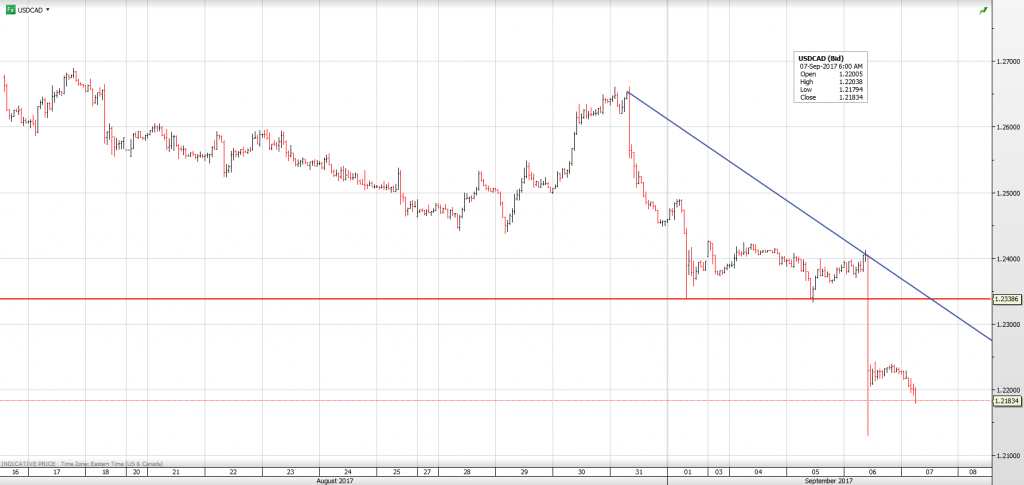The US dollar has started the New York session with losses across the board. Concerns ahead of today’s European Central Bank (ECB) meeting, Hurricane Irma and North Korea contrasted with news of a US bipartisan debt ceiling extension agreement.
Hurricane Irma is still tracking a Florida landfall, and Hurricane Mario Draghi is getting ready to hit the stage on Thursday.
AUDUSD moved higher in early Asia trading and then dropped when July Retail Sales came in at 0.0% rather than the 0.3% forecast. Prices recovered in Europe on broad US dollar weakness.
NZDUSD drifted up early, dropped in Europe and then bounced, all the while trading in a 0.7174-0.7216 range.
USDJPY was unable to add to Wednesday’s gains made after the USdebt ceiling announcement. Instead, prices declined steadily, falling from 109.25 to 108.84.
EURUSD was asleep in Asia but woke up with a start in Europe. EURUSD rallied from 1.1915 to 1.1981 by the New York open. Eurozone Q2 GDP rose 2.3%, y/y beating the 2.2% forecast.
The ECB is expected to defer a tapering announcement until October. We will know for sure in just a few hours.
UK House prices popped in August. The Halifax House Price index rose 1.1% (forecast 0.2%), and GBPUSD rose from 1.3034 to 1.3072. The soft US dollar profile helped the move.
Yesterday’s oil price rally halted overnight, in part due to the news of a 2.79 million barrel increase in US Crude inventories as reported by API. Still, WTI is hovering around $49.00/barrel
USDCAD got crushed by a perfect storm of Hurricane Irma proportions. The Bank of Canada surprised markets with a 0.25 bp hike in interest rates while delivering an upbeat statement. Oil prices were rallying, and the US dollar was sinking. That combination drove USDCAD from 1.2412 to 1.2140, yesterday. Prices consolidated in a narrow band overnight, but 1..2000 is acting like a magnet.
This morning’s ECB press conference (due at 8:30 am EDT) will set the tone for the rest of the day, and into next week US data will not be a factor, but Canadian data may have an impact. USDCAD traders will look to the August Ivey PMI and Building Permits for confirmation of the Bank of Canada’s upbeat outlook. Better than expected data will lead to a test of 1.2140.
USDCAD Technical outlook:
The intraday USDCAD technicals are bearish. The break of the former 2017 low at 1.2415 and various support and Fibonacci levels has opened the door to additional weakness. The focus in now on long term support in the 1.1950-1.2000 area. However, the speed of the drop combined suggests a period of consolidation before the next leg lower. For today, USDCAD support will be at 1.2140 and 1.2095. Resistance will be at 1.2250 and 1.2340
Today’s Range 1.2140-1.2240
Chart: USDCAD hourly






